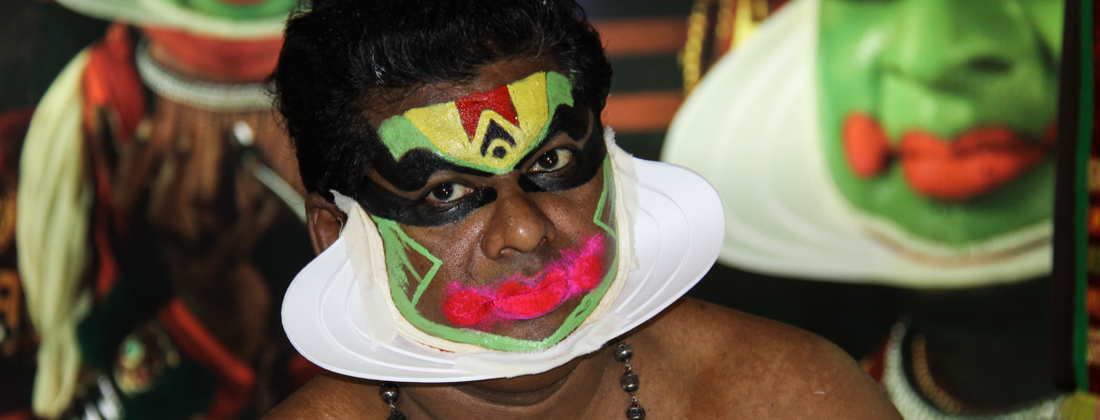
Kerala – Places to Visit
Alappuzha (Alleppey)
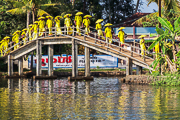
Located halfway between Kollam and Kochi, the market town of Alappuzha (formerly called Alleppey) is criss-crossed by canals and is therefore often called the “Venice of the East”. In the second half of the 18th century, the rulers of Travancore developed the city into one of the most important seaports of their empire. In the middle of the 19th century, Alappuzha became a trading center of the coir industry. In recent years, the city has developed into a tourist center for backwater tours. The boat jetty is the place where many house boat journeys start or end every day. Alappuzha is also famous for the annual snake boat race in August, the Nehru trophy boat race, which precedes the traditional Onam festival and attracts many thousands of visitors every year. In this regatta, ornately decorated boats with up to 120 rowers compete for the win.
Backwaters
Kerala is famous around the world for its numerous waterways; lined by palms, mango trees and rice paddies, they crisscross the region and are known as the ‘backwaters’. They form a vast network of waterways that extends from Kochi in the north to Kollam in the south, crossing an area of about 2000 square kilometers, consisting of 29 lakes and lagoons, 44 rivers and about 1500 canals. The largest lake, with a length of 83 km, is Vembanad Lake, which is connected to the Arabian Sea. The peaceful backwaters, serving as trade and transport routes for the locals for many centuries, are a spectacular destination for tourists. Discovering the picturesque water world on a house boat trip is an unforgettable highlight of a trip to Kerala. The romantic boats, providing all meals and comfortable accommodation for the night, are converted former rice barges.
Cheruthuruthy
A stay in Cheruthuruthy gives a fascinating insight into the traditional performing arts of Kerala. Situated in this village, located 33 km north of Thrissur, is the internationally renowned Kerala Kalamandalam, a center for nurturing Indian culture. The classes in the various disciplines such as Kathakali, Mohiniyattam, Koodiyattam, singing and music, are still conducted according to the traditional rules of the Gurukula system. In its simplicity and austerity, the Kalamandalam represents the pure atmosphere in which these art forms have managed to survive until today.
The surrounding area of Cheruthuruthy offers the opportunity of visiting traditional Nalukettu houses, constructed in the style of the old extended family houses in Kerala in which the lifestyle was primarily based on matriarchal principles as part of a complex family system. The remarkable property used to be inhabited by the extended family network of the Namboothiri, the aristocratic Brahmin family of Kerala. With their sweeping tiled roofs, the houses represent a unique Kerala architecture. A Nalukettu house is a rectangular property, consisting of four hall-like buildings, arranged around a central courtyard. Its facilities include wells, devotional areas, kitchens, pantries, utility rooms and separate living areas for married and unmarried family members. The more elaborate forms of such properties are called Ettukettu and Pathinarukettu.
Haripad
Located 33 km south of Alappuzha (Alleppey), Haripad is known in Kerala as the “Town of Temples”. In total, there are 48 Hindu temples in the town and its surrounding area. Among the best known is the remarkable Mannarasala Temple, considered one of the oldest in Kerala. It is dedicated to the worship of the fertility gods, represented by serpent beings. Hindu pilgrims from all over the world come here to pray for offspring or to honor the gods with a ceremony of thanks after the birth of a child. The strong yellow of the turmeric root reigns everywhere. Symbolizing the energies of the earth, it is attributed with special healing powers. Another attraction is the Subramanya Swamy Temple, a prestigious religious center which is famous for its exquisite Kerala architecture. The temple serves the worship of Lord Subramanya, a son of the Hindu gods Shiva and Parvati.
Kochi (Cochin)
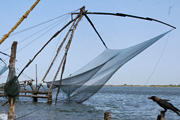 The port city of Kochi, formerly known as Cochin, is uniquely located between the Arabian Sea and the backwaters. With its rich ethnic and cultural heritage, Kochi’s atmosphere is an unforgettable experience. A variety of attractions offer insights into the rich history of the city, characterized by strong Portuguese and Dutch influences. Particularly interesting is a visit to Mattancherry and Fort Kochi, the historical city with its bustling life. Among the attractions for which sufficient time should be reserved are the winding streets with old Dutch houses, Chinese fishing nets at the waterfront, traditional spice markets, the antiquities quarter, the Jewish synagogue, the Mattancherry palace with its exquisite mythological murals and the St. Francis Church, built in 1503, where Vasco da Gama was buried until his remains were transferred to Lisbon in 1539. A special cultural attraction is the spectacular Kathakali dance theater. There are performances every evening. Situated between the Arabian Sea and the backwaters, Kochi invites the visitor to go on a tour of discovery using the local ferries, the main means of transportation between the various parts of the city. In this way, one can explore the port, the islands and the modern district of Ernakulam. Also recommended is a leisurely stroll through the antique and spice markets, which is concluded with a lunch at one of the many restaurants in the old town.
The port city of Kochi, formerly known as Cochin, is uniquely located between the Arabian Sea and the backwaters. With its rich ethnic and cultural heritage, Kochi’s atmosphere is an unforgettable experience. A variety of attractions offer insights into the rich history of the city, characterized by strong Portuguese and Dutch influences. Particularly interesting is a visit to Mattancherry and Fort Kochi, the historical city with its bustling life. Among the attractions for which sufficient time should be reserved are the winding streets with old Dutch houses, Chinese fishing nets at the waterfront, traditional spice markets, the antiquities quarter, the Jewish synagogue, the Mattancherry palace with its exquisite mythological murals and the St. Francis Church, built in 1503, where Vasco da Gama was buried until his remains were transferred to Lisbon in 1539. A special cultural attraction is the spectacular Kathakali dance theater. There are performances every evening. Situated between the Arabian Sea and the backwaters, Kochi invites the visitor to go on a tour of discovery using the local ferries, the main means of transportation between the various parts of the city. In this way, one can explore the port, the islands and the modern district of Ernakulam. Also recommended is a leisurely stroll through the antique and spice markets, which is concluded with a lunch at one of the many restaurants in the old town.
Kollam (Quilon)
The trading town of Kollam (formerly Quilon), 155 km south of Kochi, was mentioned by the Phoenicians and the Romans, and was visited in the 13th century by Marco Polo. It is a typical Kerala town with old wooden houses under red-tiled roofs, although nowadays it is increasingly characterized by a growing industrialization. For tourists, Kollam is primarily a starting or end point for backwater trips. Thirty kilometers from Kollam, in Vallikavu, is the Amritapuram ashram of Mata Amritanandamayi, a saint who is revered by many Indians and Westerners and who is known for giving a hug during darshan to every visitor who asks for one. Due to her extensive humanitarian work, Mata Amritanandamayi, affectionately called “Amma” by her followers, has gained worldwide recognition.
Kumarakom
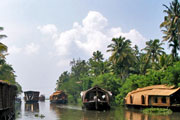 Arundhati Roy’s book “The God of Small Things” is set in a small village near Kumarakom. Its international success has contributed to the development of tourism in the wider area. Kumarakom is situated in the middle of paddy fields, mangrove forests and coconut plantations and forms a group of islands in Vembanad Lake, which is regarded as India’s longest lake. A special attraction (and a true paradise for ornithologists) is the Kumarakom Bird Sanctuary, a bird sanctuary frequented by many species of migratory birds, wintering here from November to March. Several resorts offer comfortable and stylish accommodation at the backwaters, the romantic waterways of which can be explored with traditional boats.
Arundhati Roy’s book “The God of Small Things” is set in a small village near Kumarakom. Its international success has contributed to the development of tourism in the wider area. Kumarakom is situated in the middle of paddy fields, mangrove forests and coconut plantations and forms a group of islands in Vembanad Lake, which is regarded as India’s longest lake. A special attraction (and a true paradise for ornithologists) is the Kumarakom Bird Sanctuary, a bird sanctuary frequented by many species of migratory birds, wintering here from November to March. Several resorts offer comfortable and stylish accommodation at the backwaters, the romantic waterways of which can be explored with traditional boats.
Kovalam
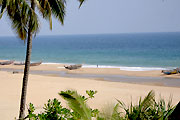 Kovalam was originally a small fishing village, which was discovered by European backpackers and expanded for tourism in the mid-90s. The small beach town, 12 kilometers south of Kerala’s capital Trivandrum, is great for swimming and relaxing. The 2 km long, curved beach is divided into two sections by a rock formation jutting out into the sea and towered over at the southern end by a distinctive lighthouse. Further north and south are other, smaller beaches. Many bars, cafes and restaurants line the beach, offering a variety of fresh seafood and continental dishes. The type of accommodation offered in the hotels and guesthouses is diverse and ranges from simple to stylish to luxurious. In addition to the beach life, there are numerous interesting wellness and Ayurveda treatments on offer.
Kovalam was originally a small fishing village, which was discovered by European backpackers and expanded for tourism in the mid-90s. The small beach town, 12 kilometers south of Kerala’s capital Trivandrum, is great for swimming and relaxing. The 2 km long, curved beach is divided into two sections by a rock formation jutting out into the sea and towered over at the southern end by a distinctive lighthouse. Further north and south are other, smaller beaches. Many bars, cafes and restaurants line the beach, offering a variety of fresh seafood and continental dishes. The type of accommodation offered in the hotels and guesthouses is diverse and ranges from simple to stylish to luxurious. In addition to the beach life, there are numerous interesting wellness and Ayurveda treatments on offer.
Munnar
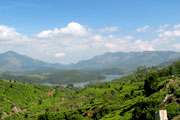 A varied drive through the picturesque countryside of southern India leads to a true paradise for nature lovers. Munnar, the “Queen of Hill Stations”, is surrounded by lush green tea plants at an altitude of 1,524 meters in the Kannan Devan hills of the Western Ghats. In the immediate vicinity is the Anamudi, the highest peak in South India at 2,965 m. The area around Munnar offers breathtaking views of the manicured tea fields that, depending on the weather, will glitter in the mild mountain sunlight or be enveloped in the mystical white of the clouds. A tea of a very special quality matures here, and the air is often permeated by the scent of freshly picked tea leaves. The area captivates, with its white-water streams, vast tea gardens, breathtaking views and rich animal life. A trip to Echo Point and Top Station will go past the scenic highlights of the region. A walk through the tea plantations with a local guide is highly recommended. A visit to the local tea museum reveals the secrets of tea production.
A varied drive through the picturesque countryside of southern India leads to a true paradise for nature lovers. Munnar, the “Queen of Hill Stations”, is surrounded by lush green tea plants at an altitude of 1,524 meters in the Kannan Devan hills of the Western Ghats. In the immediate vicinity is the Anamudi, the highest peak in South India at 2,965 m. The area around Munnar offers breathtaking views of the manicured tea fields that, depending on the weather, will glitter in the mild mountain sunlight or be enveloped in the mystical white of the clouds. A tea of a very special quality matures here, and the air is often permeated by the scent of freshly picked tea leaves. The area captivates, with its white-water streams, vast tea gardens, breathtaking views and rich animal life. A trip to Echo Point and Top Station will go past the scenic highlights of the region. A walk through the tea plantations with a local guide is highly recommended. A visit to the local tea museum reveals the secrets of tea production.
Padmanabhapuram
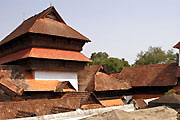 The town of Padmanabhapuram is located 40 km south of Trivandrum near the southern tip of India, and served for two hundred years, from 1550 onwards, as the residence of the Princes of Travancore, who ruled over the southern part of present-day Kerala. The city’s name is derived from Padmanabha (“Lotus-navel”), a facet of the god Vishnu who was worshiped by the rulers as a family deity. The main attraction is the wooden palace of the kings of Travancore – almost exclusively made of teak wood – which is owned by the Government of Kerala, even when Padmanabhapuram belongs to Tamil Nadu. The fascinating complex, which shows the splendor of a bygone era, is in excellent condition and is considered the greatest example of traditional Kerala architecture. The spacious complex is situated within a partly preserved defensive wall and consists of a series of buildings interconnected through several courtyards. Characteristic features are the surrounding verandas and the exquisite carvings with which the furniture, gables, staircases and columns of the 127 rooms are decorated. The wall paintings are of outstanding quality.
The town of Padmanabhapuram is located 40 km south of Trivandrum near the southern tip of India, and served for two hundred years, from 1550 onwards, as the residence of the Princes of Travancore, who ruled over the southern part of present-day Kerala. The city’s name is derived from Padmanabha (“Lotus-navel”), a facet of the god Vishnu who was worshiped by the rulers as a family deity. The main attraction is the wooden palace of the kings of Travancore – almost exclusively made of teak wood – which is owned by the Government of Kerala, even when Padmanabhapuram belongs to Tamil Nadu. The fascinating complex, which shows the splendor of a bygone era, is in excellent condition and is considered the greatest example of traditional Kerala architecture. The spacious complex is situated within a partly preserved defensive wall and consists of a series of buildings interconnected through several courtyards. Characteristic features are the surrounding verandas and the exquisite carvings with which the furniture, gables, staircases and columns of the 127 rooms are decorated. The wall paintings are of outstanding quality.
Thekkady
 In Thekkady, you are in the center of pepper-growing country. The small town of Thekkady is nestled between green tea, coffee and spice plantations in a typical South-Indian hilly landscape. Thekkady is probably the best place for buying Indian spices of the highest quality. On a visit to one of the many spice gardens, the various traditional spices can be directly experienced in nature, under the guidance of a professional. Another attraction is the Periyar National Park, which is among the best-known nature and wildlife sanctuaries in South India. On an early morning hike with official, local guides or on a boat ride on Periyar Lake, one can – with a little luck – spot elephants and a variety of other wild animals. A visit to a Kalaripayattu demonstration is also an impressive experience, providing insight into the traditional martial art of South India.
In Thekkady, you are in the center of pepper-growing country. The small town of Thekkady is nestled between green tea, coffee and spice plantations in a typical South-Indian hilly landscape. Thekkady is probably the best place for buying Indian spices of the highest quality. On a visit to one of the many spice gardens, the various traditional spices can be directly experienced in nature, under the guidance of a professional. Another attraction is the Periyar National Park, which is among the best-known nature and wildlife sanctuaries in South India. On an early morning hike with official, local guides or on a boat ride on Periyar Lake, one can – with a little luck – spot elephants and a variety of other wild animals. A visit to a Kalaripayattu demonstration is also an impressive experience, providing insight into the traditional martial art of South India.
Thiruvananthapuram (Trivandrum)
Since 1956, Thiruvananthapuram is the capital of Kerala. Its main attractions are the Padmanabhaswamy temple, built in the Dravidian style with its seven-storey gopuram, the Napier Museum, the Kuthiramalika Palace, the Sri Chitra Art Gallery and the many representational and administrative buildings from the colonial era. The many ayurvedic resorts and treatment centers in the immediate vicinity of Thiruvananthapuram offer solid Ayurveda treatments in exquisite surroundings.
Varkala
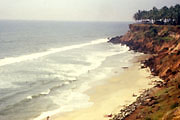 The scenic town of Varkala, located 54 km north of Thiruvananthapuram, is popular with travelers who are looking for sun and sea and favor its quiet beach below the high cliffs. The glorious long sandy beach with its backdrop of red cliffs is a wonderful place for relaxation. A series of rock-cut stairs lead down to the beach. The spectacular sunset over the Arabian Sea, a highlight of a visit to Varkala, is best enjoyed from the panoramic view up on the cliffs, 30-50 meters above the sea. The place offers excellent accommodation close to the beach, good restaurants and professional Ayurvedic massage centers. In Kerala, Varkala is known for the Janardhana Swamy temple, a sanctuary which, according to legend, is over 2000 years old. The ancestors are honored here in March or April every year during the Arattu festival.
The scenic town of Varkala, located 54 km north of Thiruvananthapuram, is popular with travelers who are looking for sun and sea and favor its quiet beach below the high cliffs. The glorious long sandy beach with its backdrop of red cliffs is a wonderful place for relaxation. A series of rock-cut stairs lead down to the beach. The spectacular sunset over the Arabian Sea, a highlight of a visit to Varkala, is best enjoyed from the panoramic view up on the cliffs, 30-50 meters above the sea. The place offers excellent accommodation close to the beach, good restaurants and professional Ayurvedic massage centers. In Kerala, Varkala is known for the Janardhana Swamy temple, a sanctuary which, according to legend, is over 2000 years old. The ancestors are honored here in March or April every year during the Arattu festival.
Wayanad
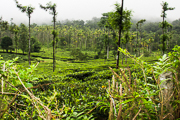 The picturesque Wayanad District is located in the northern part of Kerala at an altitude between 700 and 2100 m in the mountains of the Western Ghats. In the temperate climate here, coffee, tea, cardamom, rubber and pineapples are cultivated. Its stunning natural scenery makes Wayanad a paradise-like destination for nature lovers. Explore the green expanse and the misty hills of a mystical and unspoilt landscape. Explore traditional spice gardens and take part in hikes and jeep safaris in the Wayanad Wildlife Sanctuary, home to numerous elephants, tigers, leopards, wild buffalo, deer and other wildlife species. Also known as the Muthanga wildlife sanctuary, it is an integral part of the Nilgiri Biosphere Reserve and is visited by few tourists. For those who stay longer, you can find an interesting range of adventure activities, such as bamboo rafting, extensive bicycle tours and longer treks. From a cultural perspective, Wayanad provides inspiring insights into the local arts and crafts and the Hindu, Christian and Jewish traditions in the region.
The picturesque Wayanad District is located in the northern part of Kerala at an altitude between 700 and 2100 m in the mountains of the Western Ghats. In the temperate climate here, coffee, tea, cardamom, rubber and pineapples are cultivated. Its stunning natural scenery makes Wayanad a paradise-like destination for nature lovers. Explore the green expanse and the misty hills of a mystical and unspoilt landscape. Explore traditional spice gardens and take part in hikes and jeep safaris in the Wayanad Wildlife Sanctuary, home to numerous elephants, tigers, leopards, wild buffalo, deer and other wildlife species. Also known as the Muthanga wildlife sanctuary, it is an integral part of the Nilgiri Biosphere Reserve and is visited by few tourists. For those who stay longer, you can find an interesting range of adventure activities, such as bamboo rafting, extensive bicycle tours and longer treks. From a cultural perspective, Wayanad provides inspiring insights into the local arts and crafts and the Hindu, Christian and Jewish traditions in the region.
